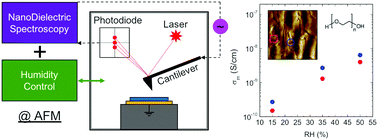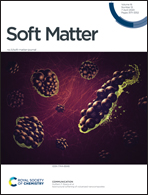Effect of environmental humidity on the ionic transport of poly(ethylene oxide) thin films, investigated by local dielectric spectroscopy†
Abstract
The effect of humidity on the ionic transport in the amorphous phase of poly(ethylene oxide) thin films has been studied by local dielectric spectroscopy. We explored a controlled humidity range between 15% RH and 50% RH. AFM-based local dielectric imaging allowed the thin film topography and the corresponding dielectric contrast maps to be obtained simultaneously. No humidity effect on the film topography was observed whereas large variation of the dielectric signal could be detected. In addition, we observed a clear dielectric contrast in different locations on the thin film surface. At selected regions with high contrast in the dielectric maps, we performed nanoDielectric Spectroscopy (nDS) measurements covering the frequency range from 5 Hz to 100 kHz. By modeling these spectroscopy results, we quantified the conductivity of the amorphous phase of the semicrystalline poly(ethylene oxide) films. The crystalline fraction of the PEO thin films was extracted and found to be about 36%, independently of humidity. However, the average conductivity increased by a factor of 25 from 2 × 10−10 to 5 × 10−9 S cm−1, by changing environmental humidity in the explored % RH range.



 Please wait while we load your content...
Please wait while we load your content...